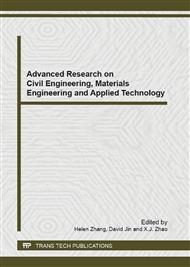[1]
Y. Song, Z.H. Li, W. C. Wang, The information rate of secret sharing schemes based on seven participants by connect graphs,J. Recent advance in computer science and information engineering, CSIE 2011, Lecture notes in electrical engineering, vol. 127, 2012, pp.637-645.
DOI: 10.1007/978-3-642-25769-8_90
Google Scholar
[2]
W. C. Wang, Z.H. Li and Song Y, The optional information rate of perfect secret sharing schemes,J. In: Proceedings 2011 International Conference on Business Management and Electronic Information. vol. 2, May, 2011, pp.207-212.
DOI: 10.1109/icbmei.2011.5917883
Google Scholar
[3]
E.F. Brickell and D.R. Stinson, Some improved bounds on the information rate of perfect secret sharing schemes, J. Journal of Cryptology, vol. 5, pp.153-166, (1992).
DOI: 10.1007/bf02451112
Google Scholar
[4]
C. Blundo, A. De Santis, D.R. Stinson and U. Vaccaro, Graph decompositions and secret sharing schemes,J. Journal of Cryptology, vol. 8, pp.39-64, (1995).
DOI: 10.1007/bf00204801
Google Scholar
[5]
C. Padró and L. Vázquez, Finding lower bounds on the complexity of secret sharing schemes by linear programming, J. Discrete Applied Mathematics, vol. 161, pp.1072-1084, (2013).
DOI: 10.1016/j.dam.2012.10.020
Google Scholar
[6]
D .R. Stinson, An explication of secret sharing schemes, J. Designs, Codes and Cryptography, vol. 2, pp.357-390, (1992).
DOI: 10.1007/bf00125203
Google Scholar
[7]
W. Jackson and K.M. Martin, Perfect secret sharing schemes on five participants, J. Designs, Codes and Cryptography, vol. 9, pp.267-286, (1996).
DOI: 10.1007/bf00129769
Google Scholar
[8]
M. van Dijk, On the information rate of perfect secret sharing schemes, , J. Designs, Codes and Cryptography, vol. 6, pp.143-169, (1995).
DOI: 10.1007/bf01398012
Google Scholar
[9]
H. M. Sun and B. L. Chen, Weighted decomposition construction for perfect secret sharing schemes, , J. Computers & Mathematics with Applications, vol. 43, pp.877-887, (2002).
DOI: 10.1016/s0898-1221(01)00328-5
Google Scholar
[10]
M. Gharahi and M.H. Dehkordi, The complexity of the graph access structures on six participants. Designs, J. Codes and Cryptography, vol. 67, pp.169-173, (2013).
DOI: 10.1007/s10623-011-9592-z
Google Scholar
[11]
R. M. Capocelli, A . De Santis, L. Garg ano and U . Vaccaro. On the size of shares of secret sharing schemes, J, Journal of Cryptology, vol. 6, pp.157-168, (1993).
DOI: 10.1007/bf00198463
Google Scholar
[12]
T .M. Cover and J.A. Thomas. Elements of information theory. 2nd ed. New York: Wiley, (2006).
Google Scholar
[13]
D. R. Stinson. Cryptography theory and practice. 3rded. London, New York: Chapman & Hall/CRC, Boca Raton, (2006).
Google Scholar
[14]
L. Csirmaz, The size of a share must be large, J. Journal of Cryptology, vol. 10 , pp.223-231, (1997).
DOI: 10.1007/s001459900029
Google Scholar


